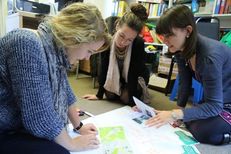Institutional prioritisation of Living Labs through creation of resource and inclusion in the University’s Environmental Sustainability Vision, Policy and Strategy
What advice would you give an institution staff member keen to get this started?
“The main thing would be identifying where there are synergies of this already taking place, i.e. where there is research and an appetite from operations to have research to help them make sustainable change. The Living Lab is such a fluid concept you could do it at so many different levels.” – Amy Munro-Faure, Living Laboratory for Sustainability Coordinator
Formal coordination of the Living Laboratory at Cambridge has been taking place for the past 6 years.
This coordinated approach came out of the successful execution of a project in the Cambridge Engineering Department, where the benefits and impacts of putting research into practice demonstrated potential for future projects.
The University has highlighted its recognition of the value of Living Labs through the inclusion of this work in the University’s Environmental Sustainability Vision, Policy and Strategy as well as creating the role for a Living Lab Coordinator within the Estates Management division. This has provided a driving force to create collaborations and develop and communicate living lab opportunities. Within the University, the Living Lab Coordinator works within the Environment and Energy section but is tied closely to work related to education for sustainability and biodiversity. The role bridges the gap between operational staff and academics at the university whilst also reaching out and connecting with the wider community in search of mutually impactful partnerships.
“The Cambridge Living Lab is very much about taking research and linking it with practice, and then engaging with students and taking the outcomes from it.” – Amy Munro-Faure, Living Laboratory for Sustainability Coordinator,
Living lab projects at Cambridge are initiated in a variety of ways:
- Academic Projects: Students and academic staff can contact the Living Lab Coordinator who will connect them with relevant estates staff to initialise projects. PhD students also generate a lot of momentum around Living Labs.
- Voluntary Projects: The Living Lab coordinates a number of voluntary projects, for example, working with Cambridge Hub, a community organisation, where opportunities are created for students to engage with environmental change through their lives and courses.
- Internship Programme: The Environment and Energy section take on 3 interns annually to develop and delivery specific projects (internships take place over the summer and are paid).
- Awards: Students are invited to participate in idea generation competitions based around specific themes, ideas from these are then implemented where feasible. This year the theme is likely to be plastics, last years was travel.
In many instances, Living Lab project successes tend to occur where synergies already exist between research interest and operational staff or community groups’ priorities. For example, sustainable food –operational interest already existed, looking at organic farming, practices and accreditation, and there was an institutional interest in developing a food policy to support this. The Living Lab Coordinator was able to connect the relevant academics and operational staff and support them to ensure the research continued to build, which has resulted in a new food policy for the University. Projects such as this help to demonstrate the value of a Living Lab.






 Except where otherwise stated, content on this site is
licensed under a Creative Commons Attribution 3.0 License.
Except where otherwise stated, content on this site is
licensed under a Creative Commons Attribution 3.0 License.
